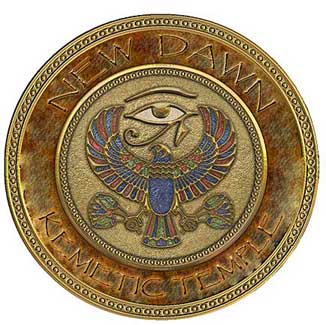|
|
|


~Brian Rosewood~
The ancient Egyptian god, Bes, who may not have originated
in Egypt but who was certainly made into a pure Egyptian god, had a number of
attributes which changed over time. In the Old Kingdom, he was shown to be associated
with fertility, circumcision and various harvest rituals. By the Middle Kingdom,
he had evolved into a guardian of the home, infants and new mothers and was
a protector of pregnant women. As time passed, his depiction as a dwarf became
common, sometimes shown with drums or a tambourine, playing the flute or dancing
in his role associated with joy, sex and pleasurable pursuits. By the Greco-Roman
Period, his appearance became more menacing, and he was often shown with knives
and swords and thus took on the role of protector in warfare against evil forces.
However, during the Greco-Roman Period in the Bahariya Oasis, Bes was honored
perhaps for his earlier attributes related to pleasure, and at El Bawiti, the
major community in the Oasis, he was the god of wine made from grapes and dates.
The importance of these products to the region is evidenced by the only known
temple dedicated to Bes in Egypt.
This temple was discovered by a resident of El Bawiti in 1988, so as discoveries go in Egypt, it is fairly recent. This individual discovered an inscribed piece of basalt within the old section of El Bawiti, which prompted the local antiquity authorities to investigate the site. Interestingly, this artifact was carved with the cartouche of Akhenaten, and is the only evidence of this heretic pharaoh that has been found in the oasis.
This temple dates from the Greek period, but there is evidence that the cult and temple operated into the 4th century AD. The ruins measure about sixty by forty feet, oriented north-south and was made of mudbrick on a limestone block foundation.
Originally, there was apparently a ramp or causeway, probably lined with sphinx, that lead to the temple's northern entrance. Fragments of the sphinxes were discovered, and Dr. Hawass, who investigated the site, believes that they were probably destroyed by early Christians of the Oasis. The entrance communicated with a long hall that was probably a public area for worshipping Bes. On the stucco floor of this hall a statue of Bes was discovered in three pieces. It is probably the best preserved statue of this god ever found in Egypt, measuring about four feet in height with features that are finely carved and still show traces of the original paint used to adorn the figure.
Here, there was also discovered copper vessels that may have originally held offerings to Bes (undoubtedly including some of the best wine produced in the Oasis). There is a small door that leads off this hallway down a sort ramp to a water shaft that was apparently used for cult purposes.
Behind the main entrance hall was an inner sanctuary surrounded by private rooms and annexes. However, there is evidence that suggests that this inner section of the temple originally took the form of two main halls that were converted into nine smaller rooms at the end of the Roman period.
A number of artifacts were discovered in the inner sanctuary. They included a faience figure, presumed to be a shabi, but wearing a tight dress and adorned with a royal false beard. This figure was carved with his hands across his chest and a tight fist holding a tool in the shape of the hieroglyph for a pyramid. An amulet made of red copper was also found in the form of a seated cat, along with a miniature statuette of Horus. In addition, a round game board made of sandstone was discovered with two concentric circles. Within these circles were small depressions that most likely held game pieces. Along with the game, a die with faces numbered one through six was also found.
Other items found within the sanctuary include two copper bowls, one of which was decorated with plants. These were probably used to hold wine, but another copper dish on three legs was probably used for burning incense. Finally, a bowl made of red Nile clay was unearthed that probably dates to as late as the third or forth century AD.
Bes was a fairly major Egyptian god, and considering that this is the only known temple dedicated to him in Egypt, the site is of considerable importance. In fact, some other ruins in the Oasis have been discovered where figures of Bes exist, certainly making this one of the main areas for the worship of this god.